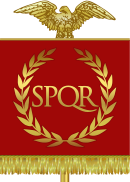
Back الجيش الروماني Arabic Exércitu romanu AST Войска Рымскай імпэрыі BE-X-OLD Древноримска армия Bulgarian Rimska vojska BS Exèrcit romà Catalan Romerske hær Danish Ρωμαϊκός στρατός Greek Romia armeo Esperanto Ejército romano Spanish
| Exercitus Romanus | |
|---|---|
 | |
| Active | 753 BC – 1453 AD |
| Country | Roman Kingdom Roman Republic Roman Empire Western Roman Empire Byzantine Empire |
| Size | 28–50 legions |
| Headquarters | Aquincum Bonn Lauriacum Isca Augusta Alexandria Singara Regensburg Novae Busra |
| Motto(s) | 'Gloria Exercitus' |
| Engagements | Roman–Gallic wars Samnite Wars Pyrrhic War Punic War Macedonian Wars Jugurthine War Mithridatic War Gallic Wars Roman civil wars Roman invasion of Britain Roman–Germanic wars Domitian's Dacian War Trajan's Dacian Wars Roman–Parthian War of 58–63 Jewish–Roman wars The Great Illyrian Revolt |
| Commanders | |
| Commander-in-chief | Emperor (de facto; 27 BC–1453 AD) Consuls (de jure; 27 BC–887 AD, 509 BC–27 BC) King (753 BC–509 BC) |
| Notable commanders | Marcus Furius Camillus Scipio Africanus Gaius Marius Julius Caesar Germanicus Flavius Stilicho Flavius Belisarius |

The Roman army (Latin: exercitus Romanus) was the armed forces deployed by the Romans throughout the duration of Ancient Rome, from the Roman Kingdom (753 BC–509 BC) to the Roman Republic (509 BC–27 BC) and the Roman Empire (27 BC–476 AD), and its medieval continuation, the Eastern Roman Empire. It is thus a term that may span approximately 2,206 years (753 BC–1453 AD), during which the Roman armed forces underwent numerous permutations in size, composition, organisation, equipment and tactics, while conserving a core of lasting traditions.[1][2][3]
- ^ The Complete Roman Army, Adrian Goldsworthy Thames & Hudson, 2011
- ^ Companion to the Roman Army, Paul Erdkamp, John Wiley & Sons, 31 March 2011
- ^ Southern, Pat (2007). The Roman Army: A Social and Institutional History. Oxford University Press. ISBN 978-0-19-532878-3.